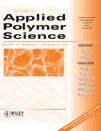Poly(butylene terephthalate)/clay nanocomposite compatibilized with poly(ethylene-co-glycidyl methacrylate). I. Isothermal crystallization
Abstract
Poly(butylene terephthalate) (PBT)/clay nanocomposite was prepared by blending PBT and commercial modified montmorillonite clays via a extruder by using poly(ethylene-co-glycidyl methacrylate) (PEGMA) as a compatibilizer (PBT/PEGMA/Clay). PEGMA and clay were also blended with PBT to prepare PBT/PEGMA and PBT/Clay, respectively. The morphology was investigated by wide-angle X-ray diffraction (WAXD), scanning electron microscopy (SEM), and transmission electron microscopy (TEM). The clays were aggregated together and phase separation was observed in PBT/Clay. The clays were exfoliated in PBT/PEGMA/Clay. The equilibrium melting temperature was estimated by linear and nonlinear Hoffman-Weeks relation. The influence of the PEGMA and clay on the PBT crystallizable ability was also investigated by Avrami model and undercooling (difference between crystallization and equilibrium melting temperature). Hoffman-Lauritzen relation was used to estimate chain fold surface free energy. The exfoliated silicates cause a large number nucleus center to enhance the crystallization in PBT/PEGMA/Clay. The presence of PEGMA can react with the PBT and an increase in viscosity would reduce molecular mobility and crystallization in PBT/PEGMA. The aggregated clays have a confinement effect on the segmental motion of PBT and hinder the crystallization in PBT/Clay. © 2008 Wiley Periodicals, Inc. J Appl Polym Sci, 2008




